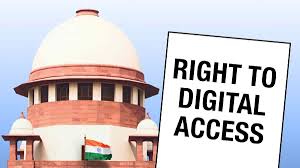
Right to Digital Access: A New Fundamental Right
Right to Digital Access: A New Fundamental Right
Introduction
In today’s world, digital technology has become part of everyday life. We use the internet for learning, talking to others, getting government services, and many other important activities. Because of this, having access to digital tools and the internet is becoming very important. Recently, the Supreme Court of India said that the Right to Digital Access is a fundamental right protected under Article 21 of the Constitution, which guarantees the right to life and personal freedom. This decision is an important step toward making sure everyone can take part in the digital world.
What is the Right to Digital Access?
The Right to Digital Access means that every person should be able to use digital devices and the internet. It is not only about having devices or connections but also about being able to understand and use these technologies. This right is now part of the right to life because living with dignity today often requires being connected digitally.
The Supreme Court recognized that without digital access, many people may miss out on their basic rights like education, information, and freedom of speech.
How is the Right to Digital Access Connected to the Constitution?
Article 21 and the Right to Life
Article 21 says that no person can be denied life or personal liberty unless the law says so. Over time, courts have said that the right to life means more than just being alive. It means living with dignity and having basic things needed for a good life.
The Court’s View on Digital Access
The Supreme Court said that digital access is part of this right because many important activities happen online now. If people do not have access to the internet, they may not be able to get education, healthcare, or government help. So, digital access is necessary to enjoy many other rights.
Why is the Right to Digital Access Important?
Closing the Digital Gap
In India, there is a big difference between people who have internet access and those who do not. This gap is even larger between cities and villages, rich and poor, men and women. Recognizing this right means the government must work to reduce this gap and make sure everyone can get online.
Access to Services and Education
Many government services, schools, and hospitals now use digital platforms. Without internet access, some people cannot use these services. For example, during the COVID-19 pandemic, many students had to study online, but those without the internet were left behind. Protecting this right ensures equal access to important services.
Freedom of Speech and Information
The internet allows people to share ideas and get news easily. Without digital access, people might miss out on these freedoms. Protecting the right to digital access supports free expression and helps people stay informed.
Challenges in Making Digital Access a Reality
Infrastructure Problems
Many parts of India still do not have good internet connections or access to devices. Building this infrastructure in remote and rural areas is difficult and expensive.
Cost and Skills
Even if internet is available, many people cannot afford devices or monthly charges. Also, not everyone knows how to use digital tools properly. Digital education and affordable pricing are needed to solve this.
Privacy and Safety
When people use the internet, their personal information can be at risk. To protect the right to digital access, strong laws are needed to keep data safe and prevent cyber crimes.
Government Efforts to Promote Digital Access
Digital India Program
The government’s Digital India initiative works to improve internet services and digital literacy. It aims to make government services easier to access online and spread digital awareness.
Expanding Connectivity
Efforts to provide public Wi-Fi and increase broadband connections in villages help more people get online.
Making Devices Affordable
Programs that provide affordable or subsidized digital devices can help poor and marginalized people join the digital world.
How to Make the Right to Digital Access Work for Everyone
Strong Laws and Rules
There should be clear rules to make sure internet services are fair, affordable, and open to all without discrimination.
Teamwork Between Groups
Government, companies, and non-profits need to work together to improve infrastructure, reduce costs, and teach people how to use technology.
Digital Education for All
Training programs should be available for everyone, especially women, older people, and those in rural areas, so they can use digital tools confidently.
Protecting Privacy
People must feel safe using the internet. This means laws and systems to protect their personal information and prevent misuse.
Conclusion
The Supreme Court’s decision to make the Right to Digital Access a fundamental right is very important for India’s future. It recognizes that in today’s world, being connected digitally is necessary for a good life and to enjoy other rights. To make this right real, we need better internet infrastructure, affordable services, digital education, and strong privacy protections. If this happens, everyone can take part in the digital world, which will help build a fairer and more equal society.